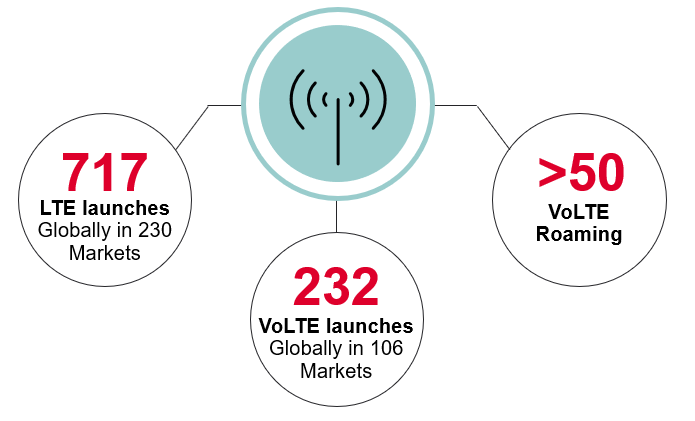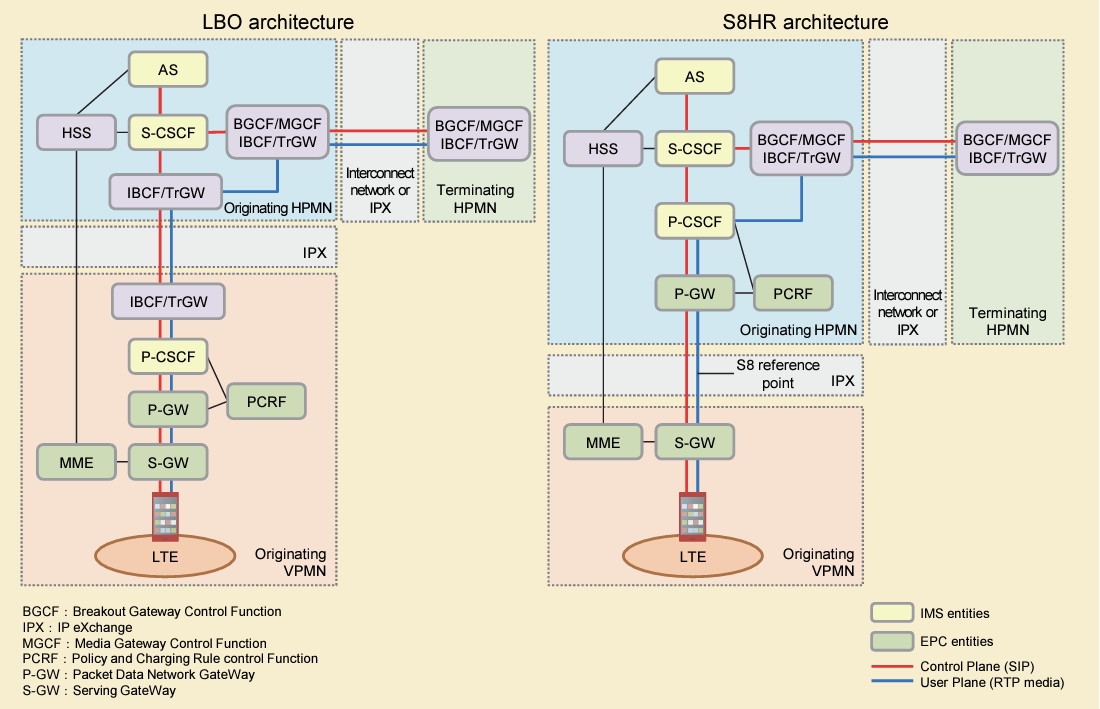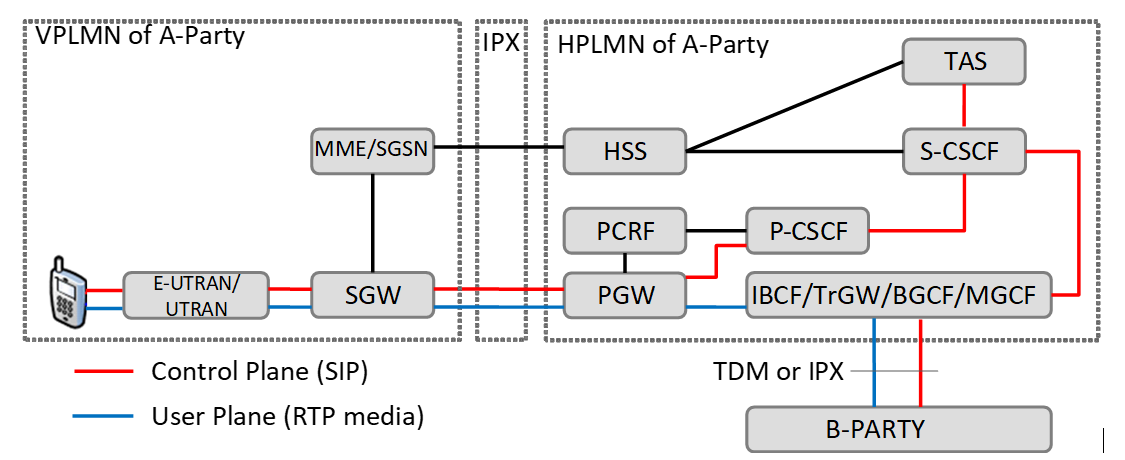The 3rd Generation Partnership Project (3GPP) architecture has introduced a subsystem known as the IP Multimedia Subsystem (IMS) as an addition to the Packet-Switched (PS) domain. IMS supports new, IP-based multimedia services as well as interoperability with traditional telephony services.
Voice Over LTE (VoLTE) is the technology to provide Voice service over LTE, However, not all countries deployed VoLTE as the primary voice option in their network and still rely on the legacy network (2G and 3G) for voice services by the CSFB or Circuit Switching Fallback.
Why VoLTE is needed?
With the advent of 5G, there is an industry need to re-farm existing 2G/3G spectrum for new 5G services. This can only happen when alternative options replace legacy 2G/3G services. Here VoLTE is coming into the picture to help the MNOs shut down 2G and/or 3G to give more spectrum room for the advanced technologies of 4G and 5G.
The growth of the VoLTE Roaming
As per GSMA, 2021 Q4, LTE deployment is globally ubiquitous with over 700 launches worldwide. While LTE data roaming agreements are widespread too. In turn, network operators in 230 markets have launched VoLTE domestically. Around 50 of those have deployed VoLTE Roaming.

What is VoLTE Roaming?
VoLTE Roaming provides the ability to extend IP Multimedia Subsystem (IMS) applications outside of a user’s serving area. That means the customer with VoLTE capabilities can enjoy the VoLTE services features from high-quality calls, quick call connections and video calls even when out of the country. when overseas. In addition, any VoLTE customer who comes to the country (which supports VoLTE) can enjoy the same features.
Now, VoLTE roaming has become a major focus of mobile operators’ attention. Many are involved in discussions about Local Breakout (LBO) and S8 Home Routed (S8HR) roaming models that are ongoing within the GSMA and 3GPP standards and specifications communities.
VoLTE Roaming Status

VoLTE Roaming Architecture
The guidelines for standardized VoLTE roaming and interworking have been outlined within the GSMA’s Permanent Reference Document (PRD) IR.65. The document describes two reference architectures for IMS Roaming.
- LBO (Local Break-Out) architecture to enable VoLTE Roaming. Requiring that the IMS functionality is split between the VPMN and HPMN. Therefore, the VPMN is IMS-service aware, and both HPMN and VPMN must have deployed IMS. Additionally, they need to support an inter-IMS interface between the constituent network elements in the VPMN-IMS and HPMN-IMS respectively.
- S8HR (S8 Home Routed) architecture. The creation of the S8HR architecture option removed the dependency of the HPMN and VPMN both having to deploy IMS. Moreover, it simplifies the roaming interface. Since it’s based on the less complex GTP-based S8 reference point, between the VPMN SGW and the HPMN PGW elements. Note: S8 is a standard reference interface between the Serving Gateway (SGW) and the Packet Data Network (PDN) Gateway (PGW).
There are IMS-level roaming interfaces in LBO architecture and no IMS-level roaming interfaces in S8HR architecture.

Which Option is commonly used and Why?
S8HR, which uses the LTE S8 interface for transporting VoLTE traffic between the visited and home network as data traffic, has recently gained momentum. The main reason is that S8HR implementation is simpler to implement than LBO, resulting in faster time to market for global VoLTE roaming deployment. Unlike LBO, S8HR does not require IMS in the visited LTE network and therefore IMS interoperability testing is not required between the home network and each visited network. This significantly simplifies the implementation.
So we can conclude the S8HR benefits as below:
- IMS Signaling by SIP Protocol is performed directly between UE and P-CSCF in the HPLMN. So the control will be handled by the HPLMN without any relay on the VPLMN.
- The P-CSCF in HPLMN is only accessed by the UE that is deployed in the HPLMN and it’s not accessed by any other UE.

S8HR Implementation Challenges
- Not all services normally provided by the visited network can continue to be provided with S8HR. As VPLMN in S8HR does not use IMS, therefore, the visited network is not service-aware. As a result, it cannot support Lawful Interception and non-authenticated user emergency calling for visiting end users. In many countries, Lawful Interception and emergency calling for visiting end users are required by local regulators.
- End-user experience in situations of 4G handover to legacy 2G/3G, enabled by SRVCC/eSRVCC. Because all visiting end-user calls in S8HR go back to the home network for routing, the SRVCC/eSRVCC signaling to initiate the handover also goes back to the home network. This can result in significant handover delay and “dead air” time for the end user.
- 3GPP has defined how to do SRVCC for S8HR VoLTE Roaming, but issues have been observed (e.g. more calls being dropped when using SRVCC than not using SRVCC). It is recommended that SRVCC is not used for roaming UEs.
- As operators deploy VoLTE services on their network, they will design QoS policy as per their requirements and network design. The QoS policies on the visited network and home network will have differences in most cases. Care must be taken when designing the QoS policy for inbound roamers and communicating early on with the roaming partner. For example, for ViLTE service, some operators have chosen to use GBR (Guaranteed Bit Rate) QCI 2, whereas, some have chosen to use a Non-GBR (typically QCI 8). The QCI values to be supported for roaming are dependent on the roaming agreement.
- IPv4/IPv6 Compatibility Issues, Not all devices request IPv4/v6 – some only request IPv4 on all APNs. Some UEs request IPv4 only for emergency calls and Not all operators support IPv6 – and in this case, if the device only requests IPv4, the request will fail.
References:
- IMS Roaming, Interconnection, and Interworking Guidelines Version 34.0 03 May 2021.
- GSMA, Your guide to accelerating VoLTE Roaming, and its importance to your business.
- Metaswitch, VoLTE Roaming.
- GSMA, VoLTE Implementation Guide.
- Signalling requirements for emergency telecommunication service in an IMS roaming environment
